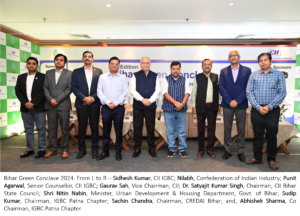Patna, 25 Sept 2024: CII Bihar and Indian Green Building Council Patna, organised the 3rd edition of ‘Bihar Green Conclave’ with theme Greening Residential, Office and Interior Spaces at Hotel Lemon Tree, Patna.
Speaking on the occasion, Nitin Nabin, Minister, Urban Development & Housing Department realised the need of green construction in the state and said, “the state government would encourage the green construction practices being a promoter of the concepts to encourage all the stakeholders from the building industry.” He stressed on two factors which would be instrumental in making government a promoter of green building practices – Scope in converting the existing government projects and mandating the new upcoming projects as green compliant and bringing suitable policies to encourage green construction in the state. He further mentioned on exploring various policies on incentivising green buildings by other states in the country and adopting best suitable policy for Bihar. The minister invited all the relevant parties such as CII-IGBC, CREDAI, IIA to join hands with Urban Development & Housing Department and help in finalising the most suitable policy for the state. He also mentioned few of the existing practices at city and municipal level towards making Bihar a sustainable built state such as segregation of waste, water conservation etc.
Dr. Satyajit Kumar Singh, Chairman, CII Bihar State Council, Director, Ruban Memorial Hospital spoke about sustainability in healthcare facilities. He said, “Introducing green concepts in the healthcare facilities can help address National issues like infection, epidemics, handling of bio-medical waste, water efficiency, energy efficiency, reduction in fossil fuel use for commuting, consumer waste and in general conservation of natural resources. Most importantly, these concepts can enhance patients’ health, recovery and well-being”.
Spearheading the green building movement in India from over two decades, CII-IGBC with the support of all the stakeholders has facilitated India to become one of the top three countries in the world in terms of largest registered green building footprint. As on date, over 14,400 green building projects, amounting to over 12 billion sq. ft. are adopting IGBC green building rating systems.

Sudip Kumar, Chairman, IGBC Patna Chapter and Chairman, LaaCasa Developers said, The need of certifying the project ultimately becomes the end result of the overall efforts put in by many stakeholders in a project, starting with the vision of the developer/project owner, design team, MEP team, HVAC team, the other consultants involved in the projects to the end users which feel satisfying in investing in those projects. Hence the achievement of a green certification for a project becomes an aspiring and encouraging factors for all of them to do better and keep improving the building performance on energy, water, environmental parameters.
Sachin Chandra, Chairman, CREDAI Bihar and MD, Swadha Developers urged the minister to consider and support in bringing a robust policy which could drive the adoption of green building concepts more practically. He further highlighted on various policies by the other state governments in the country.
Gaurav Sah, Vice Chairman, CII Bihar and Director, L V Best Pvt Ltd while speaking on sustainable industrial practices urged to the CII members and other industrial facility owners to envision their green mission and make their factories, manufacturing units, supply chain, warehouses etc as green complaint and contribute to the sustainable development of the state and the country.
Abhishek Sharma, Co Chairman, IGBC Patna Chapter and Principal Architect, PRAYOG concluded the inaugural by highlighting all the deliberations and assured the minister that a team comprised of CII, IGBC, CREDAI, IIA would meet him and his department to brainstorm on the best possible policy framework for the state to consider and further implement.
The conclave was attended by over 90 key stakeholders from the building industry such as developers, architects, engineers, government officials, academicians and other industrial and corporate leaders.
